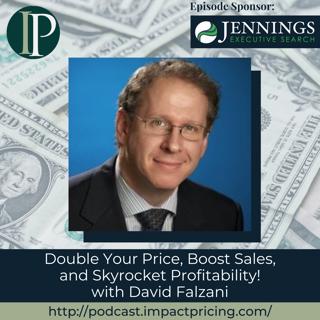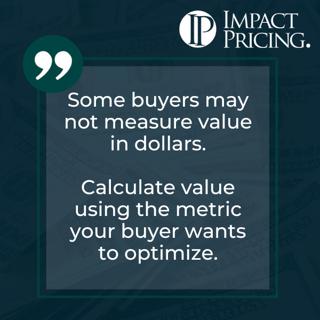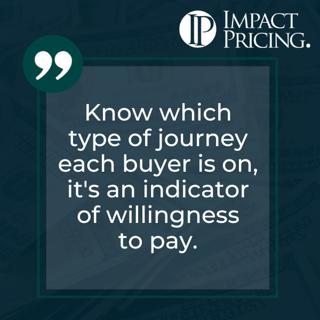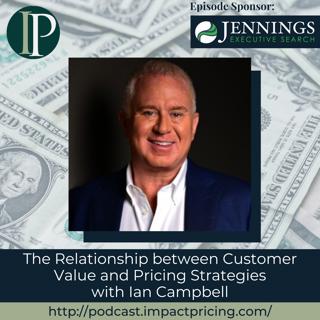
Double Your Price, Boost Sales, and Skyrocket Profitability! with David Falzani
David Falzani is a CEO at Polaris Associates and a Professor at Nottingham University. In this episode, David discusses the strategy for driving higher pricing by understanding the value delivered to customers. He also dispels the myths surrounding the notion that high pricing lowers sales, sharing the results of experiments conducted with various companies that prove otherwise. What you will learn from this episode: Learn how to achieve profitability without constantly chasing pricing Find out the underlying reasons for underpricing and dispel common misconceptions about the negative impact of higher prices on sales Discover experiments where doubling your price yields significantly higher profitability compared to low pricing strategies "Think dynamically about price and do it often." - David Falzani Topics Covered: 01:42 - Expounding on 'sustainable wealth creation' 02:54 - What caught his interest in pricing 04:36 - Three reasons why underpricing exist 06:48 - Emotional baggage and fear that comes with underpricing 08:13 - Frequency of price changes and increase 09:37 - 12 exercise the book suggests you can do to revisit your pricing strategies 12:13 - What makes companies lose confidence in pricing higher 14:37 - How to be profitable without chasing price all the time 17:01 - A case of a perfect example of understanding the relationship of pricing and customer value: Apple versus Android 18:21 - Why double your price? [And experiment you can do] 22:59 - Light double your price [an experiment for the more risk -averse] 24:29 - Looking at the numbers in terms of feasibility of price increase 26:57 - Busting myths about pricing higher 29:24 - David's best pricing advice Key Takeaways: "The frequency of revisiting your pricing decisions. Every time you revisit it, do something different, use a different piece of analysis." - David Falzani "Don't just go and revisit the same comparison to competitors or if you are using cost- plus, which I hope you're not. Think about the frequency at which you are reviewing those pricing decisions." - David Falzani "The more you look at pricing, the more questions that are raised, the more you start to educate yourself about your own customers, your clients, the market, competitors, and all those dynamics." - David Falzani People/Resources Mentioned: Thinking, Fast and Slow by Daniel Kahneman: https://www.amazon/Thinking-Fast-Slow-Daniel-Kahneman/dp/0374533555 Connect with David Falzani: LinkedIn: https://uk.linkedin.com/in/davidfalzani Connect with Mark Stiving: LinkedIn: https://www.linkedin.com/in/stiving/ Email: mark@impactpricing.com
11 Sep 202331min

Blogcast: Pricing, Usage, and Value Metrics
This is an Impact Pricing Blog published on July 27, 2023, turned into an audio podcast so you can listen on the go. Read Full Article Here: https://impactpricing.com/blog/pricing-usage-and-value-metrics/ If you have any feedback, definitely send it. You can reach us at mark@impactpricing.com. Now, go make an impact. Connect with Mark Stiving: Email: mark@impactpricing.com LinkedIn: https://www.linkedin.com/in/stiving/
8 Sep 20233min

Pricing Table Topics: Joker 2 – Buyers may not Measure Value in Dollars
This one is the Joker 2 from the Selling Value card deck. Almost always when we're dealing with B2B customers, B2B business, value can be measured in additional profit. And that's one of the things I love about B2B business and pricing, is because we know our price has to be related to how much additional profit will they make when they use our product, or when they use our product relative to a competitor's product. But it turns out, sometimes, buyers inside our customers don't really care about profit. Imagine that you're selling a piece of medical equipment and you're talking to a doctor in a big hospital. Now the doctor actually doesn't care how much additional profit you're going to make the hospital. There's an administrator someplace who cares a lot about how much additional profit you're going to make the hospital. And so, we still need to understand the profit side of this conversation. But from that doctor's perspective, they couldn't care less about profit. What do they care about? They care about the quality of the care for the patient. They care about efficacy rates. They care about how long the procedure might take. Things that really affect their world and things that matter to them. What we want to be able to do then, is as we go through our value conversations with a doctor, put value in the perspective of what that doctor cares about. So, it's not always profit, a lot of times it is, but we need to understand what each buyer truly cares about and talk about value from that perspective. We hope you enjoyed this example of Pricing Table Topics. What you just heard was done without a script. If you want to get better at speaking about pricing and value, grab a deck of our cards, pick a card, read the saying, and then talk for one to two minutes about what that card says. You'll become a better speaker and expert. If you have any questions or feedback, please email me, mark@impactpricing.com. Now, go make an impact. Connect with Mark Stiving: Email: mark@impactpricing.com LinkedIn: https://www.linkedin.com/in/stiving/
6 Sep 20232min

Master Pricing Strategies with Data with Sebastian Baier
Sebastian Baier is the founder of Buynomics, an AI for ultimate customer-centric RGM decisions- in one SaaS solution. In this episode, Sebastian discusses how Buynomics' AI utilizes vast amounts of consumer behavior data to generate virtual customers, enabling the implementation of optimal pricing strategies. What you will learn from this episode: Learn how to create a customer simulation to identify the key factors that drive the value of a product and develop effective pricing strategies for optimal results Discover how to create a customer model for B2B, even when limited data is available Learn how to effectively analyze and interpret customer data in terms of distribution rather than segment "Collect data however ugly it might look." - Sebastian Baier Topics Covered: 01:12 - What got him into pricing 02:47 - Buynomics and what it does 04:41 - Understanding customer simulation and segmentation in the way Buynomics work 08:03 - Talking about segments and distribution densities 12:24 - How Buynomics helps provide what-if analyses for pricing strategies 13:29 - Creating customer models for B2B when there are not enough data available 17:28 - Sebastian's thoughts on Mark's suggested solution for B2C clients 19:11 - Salesperson as a value driver for B2B customer simulation 19:48 - Sebastian's best pricing advice Key Takeaways: "Even if you don't have great data [with B2B], you'll use the data because you have to have a model of the world." - Sebastian Baier "To make statistics work, you have to have a certain number of customers." - Sebastian Baier "It's really very valuable just to start collecting the data, and look at them as you would as a consultant." - Sebastian Baier People/Resources Mentioned: Slack: https://slack.com/ Zoom: https://zoom.us/ Vodafone: https://www.vodafone.com/ Connect with Sebastian Baier: LinkedIn: https://www.linkedin.com/in/sebastian-baier Email: sebastianbaier@buynomics.com Connect with Mark Stiving: LinkedIn: https://www.linkedin.com/in/stiving/ Email: mark@impactpricing.com
4 Sep 202321min

Blogcast: Why Do They Buy?
This is an Impact Pricing Blog published on July 20, 2023, turned into an audio podcast so you can listen on the go. Read Full Article Here: https://impactpricing.com/blog/why-do-they-buy/ If you have any feedback, definitely send it. You can reach us at mark@impactpricing.com. Now, go make an impact. Connect with Mark Stiving: Email: mark@impactpricing.com LinkedIn: https://www.linkedin.com/in/stiving/
1 Sep 20232min

Pricing Table Topics: Joker 1 – An Indicator of Willingness to Pay
This one is the Joker 1 from the Selling Value card deck. You heard earlier that there are really three types of buyer's value journeys. Those happen to be analytical, relationship, and trust. In the analytical relationship, there's typically a lower level person who's doing a lot of side by side comparison between your product and a competitor's product, and our buyers are by far the most price sensitive in that situation. Or we could go all the way to the trust journey, and that is where they come to us. They ask us, "Hey, what do you do? How do you help us solve our problems?" They never even look at a competitive alternative. And in that situation, they're the least price sensitive. The relationship journey is the one in the middle, where people would come to us and say, "Hey, how do you help us solve our problem?" We guide them. They build a great relationship. They really like us. And then they say, "Yeah, but we have to go look at competitive alternatives." We've built up enough goodwill and probably tweaked their thinking that we have the competitive advantage. And so, they're not going to be as price sensitive as they would be if they were in a relationship journey. But they're still more price sensitive than it was just a trust journey. So, you could think of these three different journeys (the analytical, relationship, and trust) is how our customers go learn about the value of our products. But at the same time, it's how price sensitive are they going to be when it's time to negotiate the price. It's really important that we understand which journey each buyer is on. We hope you enjoyed this example of Pricing Table Topics. What you just heard was done without a script. If you want to get better at speaking about pricing and value, grab a deck of our cards, pick a card, read the saying, and then talk for one to two minutes about what that card says. You'll become a better speaker and expert. If you have any questions or feedback, please email me, mark@impactpricing.com. Now, go make an impact. Connect with Mark Stiving: Email: mark@impactpricing.com LinkedIn: https://www.linkedin.com/in/stiving/
30 Aug 20232min

The Relationship between Customer Value and Pricing Strategies with Ian Campbell
Ian Campbell is the author of Wall Street Journal Best Seller "The Value Sale". As Chief Executive Officer of Nucleus Research he is responsible for the company's investigative research approach, product set, and overall corporate direction. He is a recognized expert on the return on investment (ROI) and total cost of ownership (TCO) analysis of technology and has written and presented extensively on a range of organizational topics and the importance of matching technology to business organizational objectives. In this episode, Ian shares how you can create optimal pricing by understanding how customers use your product and find value in them. What you will learn from this episode: Learn how to quantify a product's value in measurable terms Find out the three value propositions you can derive from when helping people find and understand their product's value Discover how to restructure your conversations to help people recognize the value you offer and you get empowered to price that value "Look at the customer value, how is the customer achieving value from your product and price according to that." - Ian Campbell Topics Covered: 01:42 - How he got into pricing 02:23 - What Nucleus Research is all about 03:26 - Understanding value with how customers use the product rather than vendor claims 05:20 - Defining Value 06:48 - The challenge with quantifying ROI with non-monetary value [customers' happiness] 09:00 - Thoughts on Mark's statement about B2B being more cognizant of value they want to receive 10:05 - Translating 'happier employees' into quantifiable terms 11:19 - Selling risk and who bears the most burden in dealing with security threats 15:32 - What's it like selling for emotional reasons 19:14 - How emotional decisions relate to Danny Kahneman's decision-making theories 20:29 - Why he uses the three-year horizon [but what if a client insist on using a 5-year time frame] 24:00 - Why there are only three value propositions you can derive from 26:15 - Helping people [existing and new customers] find value in your product 28:22 - How to structure your conversation that people understands and find value in your product 29:50 - Ian's pricing advice Key Takeaways: "Technology is around delivering value, not necessarily what's the best, but what's the best for you and understanding that." - Ian Campbell "When you talk about value, we look at value in four different categories, and there are value categories that are for instance happier employees. And that's not something I can necessarily quantify, but for a customer and for a company, that could be something very, very valuable for them and that could be their objective." - Ian Campbell "Today, more than ever, it's important to draw a link between what you sell and how you deliver bottom line benefits. Otherwise, you're going to have a tougher time beating out not just your competitors, but all of the other projects they could be doing." - Ian Campbell "If you're selling with value, realize that value is a tool to help you sell. Value is not a consulting project, don't turn it into a consulting project. Turn it into a tool that helps you close the deal." - Ian Campbell People/Resources Mentioned: Daniel Kahneman: https://en.wikipedia.org/wiki/Daniel_Kahnemanhttps://en.wikipedia.org/wiki/Daniel_Kahneman Salesforce: https://www.salesforce.com Gartner: https://www.gartner.com/enhttps://www.gartner.com/e Forrester: https://www.forrester.com/boldhttps://www.forrester.com/bold Connect with Ian Campbell: LinkedIn: https://www.linkedin.com/in/iancampbellnucleusresearch/ Email: ian@nucleusresearch.com Connect with Mark Stiving: LinkedIn: https://www.linkedin.com/in/stiving/ Email: mark@impactpricing.com
28 Aug 202332min

Blogcast: It's Too Expensive!
This is an Impact Pricing Blog published on July 13, 2023, turned into an audio podcast so you can listen on the go. Read Full Article Here: https://impactpricing.com/blog/its-too-expensive/ If you have any feedback, definitely send it. You can reach us at mark@impactpricing.com. Now, go make an impact. Connect with Mark Stiving: Email: mark@impactpricing.com LinkedIn: https://www.linkedin.com/in/stiving/
25 Aug 20232min






















